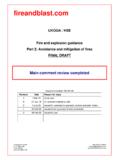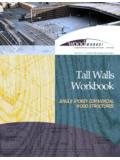Transcription of Appendix 2 Technical Background Note - Solent Composite S
1 Appendix 2 Technical Background Note Title: The assessment of fire, blast barriers, escape routes and temporary refuges (TRs) Introduction This document sets out the Technical Background for the interventions to evaluate the robustness of arguments made by duty holders (DH) to support the ALARP position for mitigation against the effects of fires and explosions on offshore installations. In order to gain sufficient confidence in ALARP arguments, it is envisaged that a starting point for data input will be the safety case and data on hydrocarbon releases. Additional information gained through the inspection activity, post acceptance inspection topic (PAIT) issues should also be reviewed prior to undertaking these interventions. Background /objectives The major emphasis is to give assurance of life cycle integrity. Therefore, with regards to the management of fire and explosion risks, these interventions aim to review: 1.
2 Whether the original assumptions regarding integrity are valid. are the load and response analyses sufficiently robust to support Technical ALARP arguments in the safety cases? 2. Physical changes to the installation that may impact on the risk and require additional risk reduction measures to be reviewed/adopted. 3. Deterioration in the plant/structure condition, in particular the weathering of passive fire protection (PFP) systems and failures in the pressurised containment of the temporary refuge (TR), and its effect on the continuing suitability of the installation. 4. The management system that captures the above is suitably robust and enables critical changes to be incorporated into the DH review and instructions given to key personnel. The basis of these interventions will be to focus on key installations that carry a higher than average fire/explosion risk.
3 Data from hydrocarbon releases for attended installations will be a used as a guide. Issues addressed 1. The suitability of mitigation barriers to prevent escalation, protect the TR. 2. The suitability of structures to allow escape to the TR and embarkation points and evacuatation from the installation. 3. In service performance testing, inspection and assessment of fire and explosion safety critical elements. 4. The DH management system to control the above. Detailed activity description The suitability of mitigation barriers to prevent escalation, protect the TRThis activity requires the inspector to ensure that barriers between different areas on the platform are suitable to prevent unwarranted escalation between different areas, and that sufficient time is provided such that the barriers do not impair the TR, for a defined duration.
4 Blast resistance and fire load endurance are the key Technical issues to be addressed. Generally, the fire barrier performances have been determined according to SOLAS ship requirements with regards to a basic classification, and EN ISO 13702 which has given more detailed requirements for offshore installations. Fire hazard scenario review The inspector duties are as follows: Check that all credible fire scenarios have been included in the major accident hazard (MAH) register, relevant to the structural safety critical elements (SCE). This should include: Oil pool fires in process, drilling modules and the sea (riser leaks etc). Riser jet fires. Process jet fires. Oil mist fires. Condensate fires. Accommodation fires. Fire barrier suitability review The inspector should confirm that critical barriers are suitable to resist, either all credible fire scenarios, or those risk based fire scenarios which allow risks to personnel to remain ALARP.
5 This should entail as a minimum checking the DH s installation s barriers comply with ISO 13702, which is a minimum good practice requirement. Within the DH s fire risk assessment, the barriers protecting the TR, can withstand the fire exposure and duration limits for the scenario determined. With regards to the barrier provision, the following standard classifications are relevant: Barrier Rating H=Hydrocarbon A/B=Cellulosic Stability and Integrity Duration (Minutes) Insulation Duration (Minutes) Jet Fire Stability and Integrity Duration Jet Fire Insulation Duration H120 120 120 60 60 H60 120 60 60 30 H0 120 Not suitable60 Not suitable A60 60 60 Not suitable Not suitable A30 60 30 Not suitable Not suitable A15 60 15 Not suitable Not suitable A0 60 0 Not suitable Not suitable B15 30
6 15 Not suitable Not suitable B0 30 Not SuitableNot suitable Not suitable Table 1 Barrier Ratings Exposed to Hydrocarbon Pool/Jet Fires and Cellulosic Blast barrier suitability review The blast barrier suitability is more difficult to assess. However, as the majority of the installations being reviewed are complex layouts, high inventory risk, and permanently attended it is recommended that the inspector conduct a review in line with the latest Oil and Gas UK document1. The following details the issues that should be include in the DH assessment: A complete set of explosion scenario investigations. CFD simulations of gas dispersion, zonal models, the Shell DICE model or the workbook approach if it can be justified.
7 Determination of equivalent stoichiometric cloud size. A combination of CFD and phenomenological explosion simulation with generation of exceedance curves representing frequency of overpressure exceedance. Determination and assessment of the structure and SCEs against the SLB and DLB design explosion loads including blast wind dynamic pressures. Dynamic possibly non-linear modelling of the installation and systems response. Explicit consideration of escalation and interaction between fire and explosion scenarios including the collapse of tall structures and the external explosion effects on adjacent structures, in particular the TR. Consideration of strong shock and missile generation by the explosion. The suitability of structures to allow escape to the TR and embarkation points and evacuation from the installation The inspector should check (in no particular order): Criticality of structures The DH should have a logical framework for identifying criticality of structures with regards to the blast, and duration and type of fire that such structures are needed to resist.
8 For example, this could include: Primary structural joints/members of the MSF, TR support structure to withstand a targeted jet fire. Escape routes across bridges, around/underneath process and drilling areas are suitably protected from major fires to enable escape to the TR/safe areas. Support steelwork to critical pipework/valves, such as ESDV support clamps steelwork, hangar steelwork for vent lines and deluge pipework. Note that often the support steelwork is itself attached to decks/walls/roofs that could suffer large blast displacements. Local analysis of deflection and loads on vent, deluge lines etc is a crucial part of the DH ALARP demonstration. Base supports for plant/structures where high drag loads due to blast funnelling etc could be a dominant load case, or fire scenarios could result in failure before the assumed evacuation time.
9 Evacuation walkways to TEMPSC, helideck, spider deck areas are suitable for the assessed fire/blast loads. In some cases DHs are providing GRP lightweight grating and it s suitability as a robust evacuation route should be demonstrated by the DH. Helideck structures. Endurance of structures in a fire The DH should ensure that all primary and secondary structural steelwork (or other metals) can withstand the various fire scenarios, either with, or without, additional passive protection. Within this check, the DH often quotes standard temperatures to which critical members can be exposed (see below). This should form the basis of the inspector review and additional risk based remedial measures should be continuously reviewed by the DH (refer to Table 2 below). Structural Component Typical Maximum Steel Surface Temperature and Duration Justification for Exposure Temperature & Duration Main ALARP Measures Uncertainties to be Explored with DH Supports to TR, accommodation areas and steel helideck structure.
10 400oC for 60 minutes. Note that limiting temperature for aluminium helidecks is 200oC Material yield strength unaffected within escape period and/or fire duration. PFP, separation by distance, redundancy in load paths (lost member analysis), blowdown, deluge Thermal analysis (screening) accuracy, material creep as stiffness reduced by 30% at 400oC, damage to PFP, PFP condition and performance Other primary and secondary steelwork in say process, drilling areas. 550oC, or higher. No specific time limit. At 550oC escalation by material yielding is likely. Decision to protect is an asset and PLL risk based decision PFP, redundancy in load paths, blowdown, deluge. Escalation paths, thermal analysis (screening) accuracy, material creep, damage to PFP where used Structural supports for the ESDVs and underdeck riser pipework inboard of the ESDV 200oC for 60 minutes.


